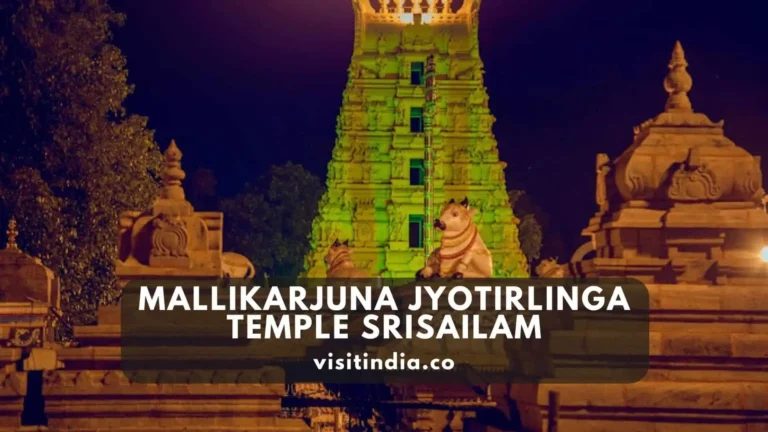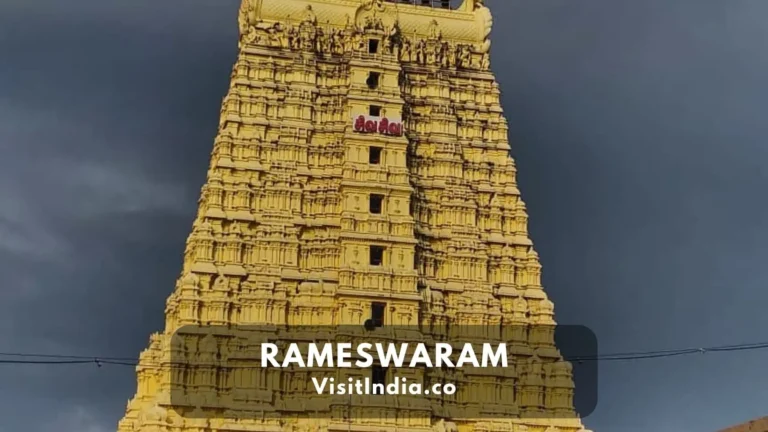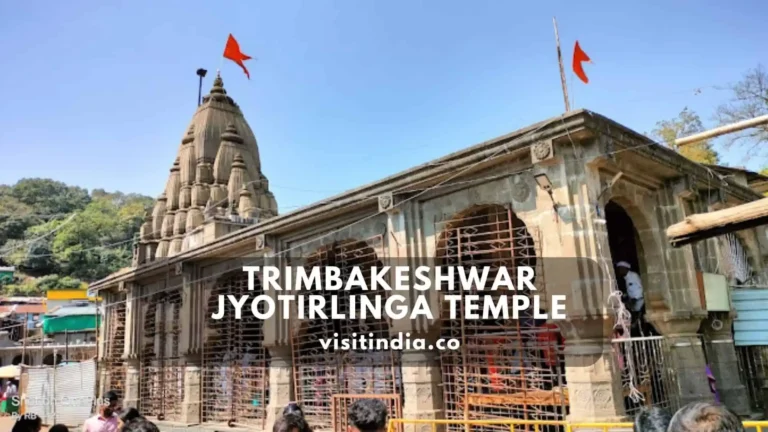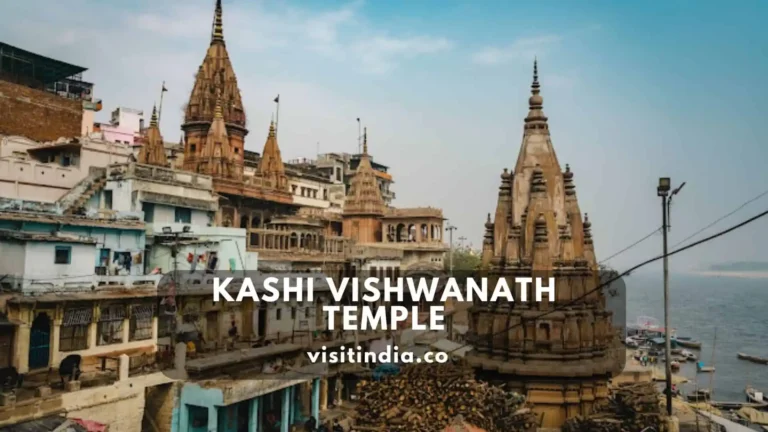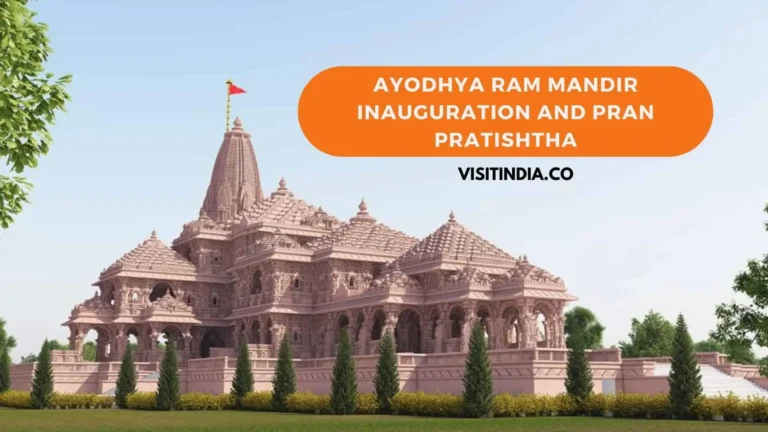Grishneshwar Jyotirlinga Temple Timings, Entry Fee, How to Reach, History, Facts
Welcome to our article on the captivating Grishneshwar Jyotirlinga Temple, a renowned Hindu temple nestled in the picturesque state of Maharashtra, India. As one of the 12 Jyotirlingas dedicated to Lord Shiva, this sacred site holds immense significance for devotees and history enthusiasts alike.
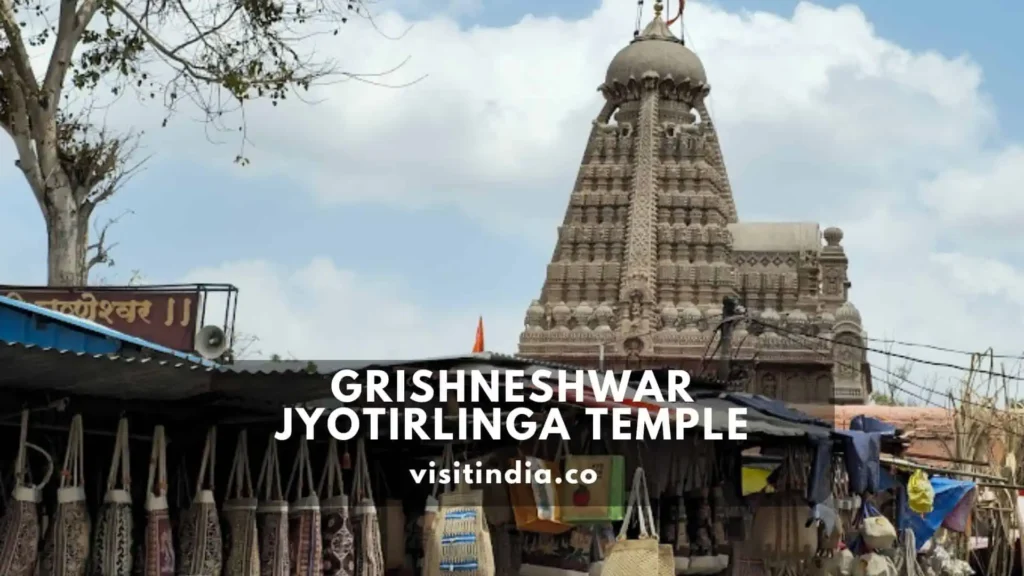
Situated near the famous Ellora Caves, just 11 kilometers away from the vibrant city of Aurangabad, the Grishneshwar Temple beckons visitors with its awe-inspiring architecture and rich cultural heritage.
Despite facing destruction in the past, the temple was meticulously reconstructed by Maratha ruler Shivaji’s grandfather, Maloju Bhisale, in the 16th century AD. Later, it was further restored to its former glory by the visionary Queen Ahilyabai Holkar of Indore in the 18th century AD.
Join us as we delve into the fascinating history, architectural marvels, and spiritual significance of the Grishneshwar Jyotirlinga Temple. Discover the various modes of transportation available to reach this sacred site and immerse yourself in the divine aura of this cherished place of worship.
Let’s embark on a virtual journey to explore the wonders of Grishneshwar Temple together.
Consider reading: 12 Jyotirlingas in India Name, Location, Significance and Details
Grishneshwar Jyotirlinga Temple Timings and Entry Fee
At Grishneshwar Jyotirlinga Temple, it’s important to plan your visit accordingly. Here are the timings and entry fee details that you need to know before visiting this holy site:
Grishneshwar Jyotirlinga Temple Timings:
- The Grishneshwar Jyotirlinga Temple opens at 5:30 AM and closes at 9:30 PM.
- During the auspicious month of Shravan, the temple remains open for extended hours from 3:00 AM to 11:00 PM.
- Please note that the temple timings might vary, so checking the schedule before your visit is always a good idea.
Time Required for Darshan at Grishneshwar Jyotirlinga Temple:
- The time required for darshan (prayer offerings) at Grishneshwar Jyotirlinga Temple is usually around 1 to 2 hours, depending on the crowd.
- It’s advisable to plan your visit accordingly, especially if you want to avoid long waiting times.
Grishneshwar Jyotirlinga Temple Entry Fee:
- There is no entry fee to visit Grishneshwar Jyotirlinga Temple. It is open to all devotees and visitors.
- However, please remember that there might be additional charges for certain rituals or religious offerings that you might choose to participate in during your visit.
Visiting hours and entry fees are important factors to consider when planning your visit to Grishneshwar Jyotirlinga Temple. By keeping these details in mind, you can ensure a smoother and more fulfilling experience at this sacred site.
Stay tuned for more information about the history, architecture, and spiritual significance of Grishneshwar Jyotirlinga Temple as we continue to explore this remarkable place.
Consider reading: Kashi Vishwanath Temple Timings, Entry Fees, How to Reach, History, Facts, Significance
Best Time to Visit Grishneshwar Jyotirlinga Temple
The Grishneshwar Jyotirlinga Temple is a significant religious site in Maharashtra, known as one of the 12 Jyotirlingas in India. If you’re planning a visit to this revered temple, it’s important to consider the best time to go. Here are some key points to keep in mind:
- Season: The temple can be visited throughout the year, but the best time to visit is during the winter and spring seasons when the weather is pleasant and the crowds are relatively low. The months of November to March are ideal for a peaceful and enjoyable experience.
- Avoid Monsoon and Mondays: It is advisable to avoid visiting the temple during the monsoon season, which is from June to September, as heavy rainfall may disrupt your travel plans and make it difficult to explore the temple premises. Additionally, Mondays tend to attract a larger number of devotees, resulting in longer queues and more crowded spaces.
- Shravan Month: If you wish to witness the temple’s vibrant atmosphere and be a part of special rituals, consider visiting during the auspicious month of Shravan. During this time, the temple extends its opening hours from 3:00 am to 11:00 pm, allowing devotees ample time to engage in prayers and seek blessings.
- Weekdays vs Weekends: To avoid large crowds, it is recommended to plan your visit on weekdays rather than weekends. This will ensure a more intimate and peaceful experience, allowing you to connect with the sanctity of the temple.
- Darshan Timings: The temple is open from 5:30 am to 9:30 pm daily, with the darshan (viewing of the deity) taking approximately 1 to 2 hours, depending on the crowd. It is advisable to arrive early in the morning or during the evening to avoid long waiting times.
Remember, the goal of visiting the Grishneshwar Jyotirlinga Temple is to seek spiritual solace and connect with the divine. By considering the best time to visit, you can enhance your experience and make the most of your pilgrimage.
Consider reading: Omkareshwar Jyotirlinga Temple Timings, Parikrama, Distance, Facts, Significance
How to Reach Grishneshwar Jyotirlinga Temple
If you’re planning to visit the Grishneshwar Jyotirlinga Temple, here’s all the information you need to know about how to reach this revered Hindu religious site.
By Air:
The nearest airport to the Grishneshwar Temple is the Aurangabad Airport, which is approximately 30 kilometers away. Several domestic flights connect Aurangabad to major cities in India. From the airport, you can hire a taxi or take a bus to reach the temple.
By Train:
The nearest railway station to the Grishneshwar Temple is the Aurangabad Railway Station, located about 30 kilometers away. There are regular train services from major cities like Mumbai, Chennai, Delhi, and Hyderabad to Aurangabad. From the railway station, you can hire a taxi or take a bus to reach the temple.
By Road:
If you prefer to travel by road, you can reach the Grishneshwar Temple by bus or taxi. Aurangabad is well-connected to major cities in Maharashtra and neighboring states by road. You can take a state-run bus or hire a taxi from Aurangabad to reach the temple. The temple is located approximately 11 kilometers away from Aurangabad.
Local Transportation
Once you reach Aurangabad or the vicinity of the Grishneshwar Temple, you can easily find local transportation options like taxis, auto-rickshaws, and buses to reach the temple. Taxis are the most convenient option for a hassle-free journey.
Other Jyotirlingas Nearby
If you’re planning a pilgrimage to multiple Jyotirlingas in India, there are other temples nearby that you can visit:
- Parli Vaidyanath Temple in Parli
- Trimbakeshwar Temple near Nasik
- Aundha Nagnath Temple in Hingoli
- Bhimashankar Temple near Pune
Remember to plan your visit to the Grishneshwar Jyotirlinga Temple in Maharashtra during the best time of the year to enhance your pilgrimage experience. Avoid the monsoon season and Mondays, and consider visiting during the winter and spring seasons for pleasant weather and fewer crowds.
Consider reading: Mallikarjuna Jyotirlinga Temple Srisailam Timings, How to Reach, History, Facts, Nearby Places to Visit
History of Grishneshwar Jyotirlinga Temple
The Grishneshwar Jyotirlinga Temple, located in the village of Verul in the Ellora Caves complex, has a rich and fascinating history dating back over a millennium. Let’s explore the origins, development, and enduring spiritual significance of this revered Hindu religious site dedicated to Lord Shiva.
- Ancient Origins: The history of the Grishneshwar Temple can be traced back to ancient times, with its roots deeply embedded in Hindu mythology. According to the legends, the temple is associated with the sage Gautama and his wife Ahilya, who inadvertently sheltered the Jyotirlinga of Grishneshwar, the Lord of Intense Heat.
- Construction of the Temple: As the sacred manifestation of Lord Shiva was found at this site, the Grishneshwar Temple was constructed to house the Jyotirlinga. Over the centuries, the temple has undergone several transformations and expansions, standing today as a testament to its enduring spiritual significance.
- Evolution and Development: The temple has evolved and grown in prominence over time, attracting countless devotees from all over the world. It has witnessed the rise and fall of various dynasties, each leaving their architectural imprints on the temple complex.
- Importance as a Jyotirlinga: Grishneshwar Temple holds significant religious importance as one of the 12 Jyotirlingas in India. Jyotirlingas are believed to be powerful manifestations of Lord Shiva, and visiting these sacred sites is considered highly auspicious for Hindu devotees.
- Cultural Significance: The Grishneshwar Temple is not only a place of worship but also a center for cultural and spiritual activities. It hosts various religious festivities, ceremonies, and processions that attract devotees and tourists alike, allowing them to partake in the vibrant traditions and rich heritage of Hinduism.
- Architectural Marvel: The temple showcases impressive architectural features, reflecting the artistic skills of the craftsmen of ancient times. Intricate carvings, detailed sculptures, and exquisite stonework are some of the notable elements that make the temple a visual delight for visitors.
Facts about Grishneshwar Jyotirlinga Temple
The Grishneshwar Jyotirlinga Temple, located in Verul village near Ellora Caves in Maharashtra, holds immense significance in Hindu mythology and attracts pilgrims from all over the world. Here are some important facts about this sacred temple:
- One of the 12 Jyotirlingas: The Grishneshwar Temple is one of the 12 Jyotirlingas, which are considered the most divine abodes of Lord Shiva. These 12 Jyotirlingas are spread across different parts of India and symbolize the infinite cosmic energy of Lord Shiva.
- Rich historical background: The temple has a history dating back over a millennium. It finds mention in the ancient Hindu scripture, Shiva Purana, and has undergone several destruction and reconstruction phases. The present form of the temple was built in the 18th century.
- Architectural marvel: The Grishneshwar Temple showcases exquisite architecture that reflects the glory of ancient Indian craftsmanship. It is adorned with intricate carvings and sculptures that depict scenes from Hindu mythology, adding to its cultural and aesthetic appeal.
- Association with Lord Shiva: According to legend, the temple is built at the spot where Lord Shiva himself manifested in the form of a Jyotirlinga, a pillar of light. Devotees believe that offering prayers at this sacred site can bring blessings, spiritual upliftment, and fulfillment of their wishes.
- Spiritual significance: The Grishneshwar Jyotirlinga Temple holds great spiritual significance for devotees of Lord Shiva. It is believed that visiting all the 12 Jyotirlingas can help attain moksha, liberation from the cycle of birth and death.
Remember to plan your visit to the Grishneshwar Jyotirlinga Temple during the best time of the year for a pleasant experience. Avoid the monsoon season and Mondays, and consider visiting during the winter and spring seasons when the weather is favorable, and there are fewer crowds.
Consider reading: Parli Vaijnath Jyotirlinga Temple Timings, How to Reach, Rituals and Festivals
Significance of Grishneshwar Jyotirlinga Temple
The Grishneshwar Jyotirlinga Temple holds immense significance in Hindu mythology and is revered as one of the 12 Jyotirlingas in India. Let’s explore the importance of this temple in greater detail:
Historical and Mythological Significance:
- The temple has a rich history dating back over a millennium and is dedicated to Lord Shiva.
- The name “Grishneshwar” is derived from the Sanskrit words “Grishna” meaning intense heat, and “Ishwar” meaning God. It translates to “The Lord of Intense Heat.”
- According to legend, Lord Shiva appeared in the form of a Jyotirlinga (pillar of light) to bless a devoted couple, Ghushma and Sudharma, who built the temple.
Spiritual Significance:
- Devotees believe that a visit to Grishneshwar Jyotirlinga Temple can provide spiritual enlightenment and fulfill one’s divine wishes.
- It is believed that Lord Shiva grants liberation or “moksha” to those who offer sincere prayers and perform rituals at the temple.
Architectural Marvel:
- The temple’s architecture showcases exquisite craftsmanship and intricate carvings.
- The temple has seen multiple reconstructions over the centuries, with the current structure reflecting the Maratha and Hemadpanti architectural styles.
Places to Visit Near Grishneshwar Jyotirlinga Temple
Grishneshwar Jyotirlinga Temple, being located near Aurangabad in Maharashtra, offers plenty of opportunities for visitors to explore the surrounding areas. Here are some of the noteworthy places to visit near the temple:
- Ellora Caves: Situated at a mere distance of 11 kilometers from Grishneshwar Jyotirlinga Temple, the UNESCO-listed Ellora Caves are a must-visit destination. This archaeological treasure houses a remarkable collection of rock-cut caves, showcasing the fusion of Hindu, Buddhist, and Jain art and architecture. With its intricate carvings and awe-inspiring sculptures, Ellora Caves offers a glimpse into India’s rich cultural and artistic heritage.
- Bibi Ka Maqbara: Known as the “Taj Mahal of the Deccan,” Bibi Ka Maqbara is a mausoleum dedicated to Aurangzeb’s wife. The striking resemblance to the iconic Taj Mahal in Agra makes it a popular attraction for history enthusiasts and architecture aficionados. Explore the exquisite craftsmanship and admire the grandeur of this architectural marvel located around 14 kilometers from the Grishneshwar Jyotirlinga Temple.
- Aurangabad Caves: Just a short distance away from the temple, the Aurangabad Caves are a group of ancient Buddhist caves dating back to the 2nd and 6th centuries. These rock-cut caves feature intricately carved sculptures, ornate pillars, and magnificent artwork, offering a glimpse into the Buddhist heritage of the region. Immerse yourself in the serene ambiance and marvel at the architectural splendor of these caves.
- Shirdi: If you wish to embark on a spiritual journey beyond the Grishneshwar Temple, a visit to the holy town of Shirdi is highly recommended. Located approximately 115 kilometers away, Shirdi is famous for the Sai Baba Temple, attracting devotees from all over the world. Seek blessings, experience the spiritual aura, and participate in the devotional activities that make Shirdi a significant pilgrimage site.
Consider reading: Somnath Temple Timings, History, Nearest Railway Station and Airport
Final Thoughts on Grishneshwar Jyotirlinga Temple
Visiting the Grishneshwar Jyotirlinga Temple in Maharashtra is an experience that combines history, spirituality, and architectural brilliance. This ancient temple holds immense significance in Hindu mythology and attracts pilgrims from all over the world.
With its proximity to the UNESCO-listed Ellora Caves, a visit to the Grishneshwar Jyotirlinga Temple offers the opportunity to explore not just the temple itself, but also the magnificent caves nearby. These caves are a testament to the rich cultural and artistic heritage of India.
Apart from the Ellora Caves, there are several other noteworthy places to visit near the temple. Bibi Ka Maqbara, Aurangabad Caves, and the holy town of Shirdi are all within reach and offer unique experiences for travelers.
Whether you are seeking spiritual enlightenment or simply want to immerse yourself in India’s rich history, a visit to the Grishneshwar Jyotirlinga Temple and its surrounding attractions is sure to leave a lasting impression. So, plan your trip and embark on a journey that will enrich your mind, body, and soul.
FAQs on Grishneshwar Jyotirlinga Temple
What is Grishneshwar Temple famous for?
Grishneshwar Temple is renowned for housing the 12th and final Jyotirlinga, making it a significant site for Shiva worshippers. Its proximity to the UNESCO-listed Ellora Caves enhances its fame, drawing pilgrims and tourists seeking spiritual and historical experiences alike.
How much time for darshan in Grishneshwar Temple?
Darshan time at Grishneshwar Temple typically ranges from 30 minutes to an hour, but it may extend up to 2 hours on peak days like Mondays, weekends, or during special festivals. Early morning visits are recommended for a quicker darshan experience. Always check the temple’s schedule beforehand as timings can change seasonally.
How to cover 4 Jyotirlinga in Maharashtra?
To cover the 4 Jyotirlingas in Maharashtra, plan a well-structured itinerary that includes visiting the temples of Trimbakeshwar near Nashik, Bhimashankar near Pune, Grishneshwar near Aurangabad, and Aundha Nagnath in Hingoli. Ensure proper travel arrangements between each location, ideally starting from Nashik and moving southwards to optimize travel time and maximize your spiritual experience.
What are the rules for Grishneshwar Temple?
The Grishneshwar Temple allows all visitors entry, yet specific customs must be respected. Men are required to be bare-chested to enter the sanctum sanctorum (garbha-griha). This adherence to Hindu tradition enriches the spiritual experience at this revered site adjacent to Ellora Caves. Always confirm with the temple for any updates on entry rules.
